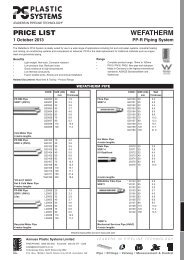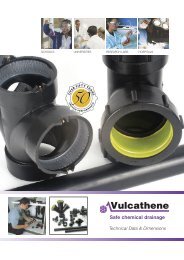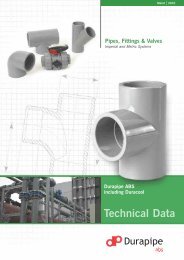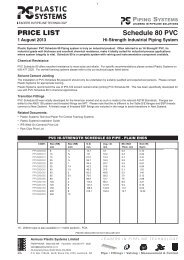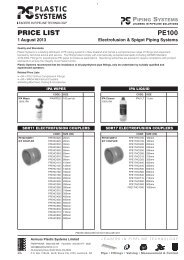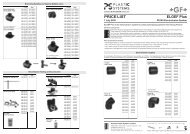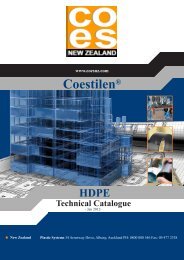Guide to Solvent Cementing PVC and CPVC Plastic ... - Glynwed Asia
Guide to Solvent Cementing PVC and CPVC Plastic ... - Glynwed Asia
Guide to Solvent Cementing PVC and CPVC Plastic ... - Glynwed Asia
You also want an ePaper? Increase the reach of your titles
YUMPU automatically turns print PDFs into web optimized ePapers that Google loves.
17<br />
HELPFUL HINTS<br />
We are all aware that a properly cemented joint is a most critical<br />
part of the installation of plastic pipe <strong>and</strong> fittings. And no matter<br />
how many times we join pipe <strong>and</strong> fittings, it’s very easy <strong>to</strong> overlook<br />
something. So, we just want <strong>to</strong> remind you of a few things you may<br />
already know.<br />
1. Have you reviewed all of the instructions on the cement<br />
container label or in ASTM D-2855?<br />
2. Are you using the proper cement for the job... for the type <strong>and</strong><br />
size of pipe <strong>and</strong> correct fittings being joined?<br />
3. Do you need <strong>to</strong> take special precautions because of unusual<br />
weather conditions?<br />
4. Do you have sufficient manpower? Do you need more help <strong>to</strong><br />
maintain proper alignment <strong>and</strong> <strong>to</strong> bot<strong>to</strong>m pipe in fitting?<br />
5. Do you have the proper <strong>to</strong>ols, applica<strong>to</strong>rs <strong>and</strong> sufficient<br />
quantities of Weld-On cements <strong>and</strong> primer <strong>and</strong> is cement in good<br />
condition?<br />
Please Note:The adding of primers, cleaners or other thinners <strong>to</strong><br />
thin the viscosity of solvent cement is not recommended.<br />
6. Remember, primer is NOT <strong>to</strong> be used on ABS pipe or fittings.<br />
7. Be sure <strong>to</strong> use a large enough applica<strong>to</strong>r <strong>to</strong> quickly spread<br />
cement generously on pipe <strong>and</strong> fittings. Then assemble immediately.<br />
8. Avoid puddling excess primer <strong>and</strong> cement inside the fitting<br />
socket, especially on thin wall, bell-end <strong>PVC</strong> pipe <strong>and</strong> ABS in any<br />
schedule.<br />
9. Do NOT allow primer or cement <strong>to</strong> run through a valve-socket<br />
in<strong>to</strong> the valve body. The solvents can cause damage <strong>to</strong> interior valve<br />
components <strong>and</strong> cause valve malfunction.<br />
10. Be aware at all times of good safety practices. <strong>Solvent</strong> cements<br />
for pipe <strong>and</strong> fittings are flammable, so there should be no smoking<br />
or other sources of heat, spark or flame in working or s<strong>to</strong>rage<br />
areas. Be sure <strong>to</strong> work only in a well ventilated space <strong>and</strong> avoid<br />
unnecessary skin contact with all solvents. More detailed safety<br />
information is available from us.<br />
11. Take advantage of our free literature on joining techniques.<br />
We offer DVDs/CDs on joining <strong>PVC</strong> & C<strong>PVC</strong> pipe <strong>and</strong> fittings, a<br />
car<strong>to</strong>on booklet illustrating joining <strong>and</strong> installation methods <strong>and</strong><br />
individual bulletins. We also offer joining seminars <strong>and</strong> job site<br />
training. Call the IPS Technical Service Department for more details.<br />
12. Finally, we remind you <strong>to</strong> INSIST ON WELD-ON!



